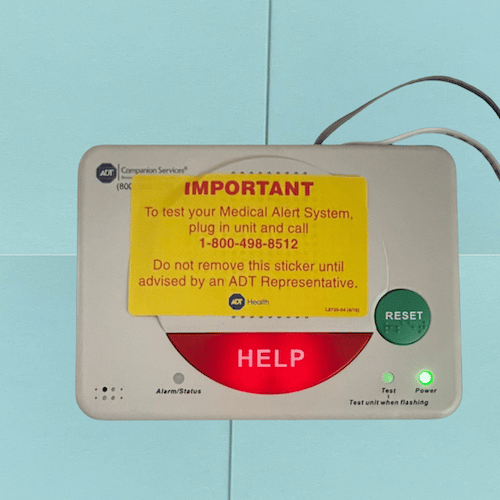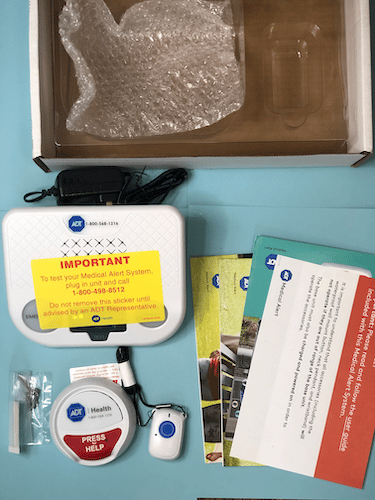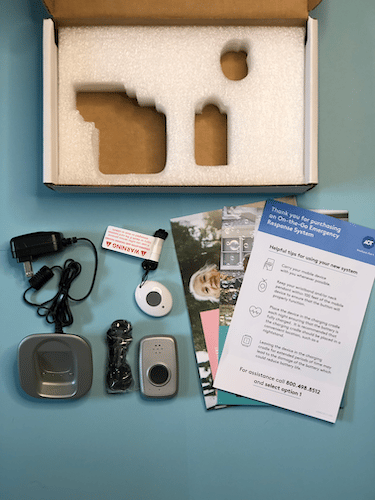ADT Medical Alert Review 2024: Cost and Feature Analysis
Key Takeaways
- ADT Medical Alert has been in the home security business for nearly 150 years and has been selling medical alert systems for more than 20 years.
- ADT currently offers two at-home systems and one on-the-go device.
- The company offers free activation and shipping, and doesn’t charge any processing fees.
Medical alert systems, also called personal emergency response systems, are a growing business for older adults who are aging in place. With so many options available from companies manufacturing and selling at-home and on-the-go systems, it’s essential to know which are the most reliable so you can choose the one that will help you feel protected in case of a fall or emergency.
In this ADT review, our Reviews Team breaks down the differences between each of these systems, how much each system costs, and how you can save money on a medical alert system.
Why you can trust our Reviews Team’s expert review
Our Reviews Team spent more than 2,500 hours conducting in-depth research on medical alert systems. During our process, we:
- Engaged in ongoing independent research
- Consulted with licensed adult caregivers and doctors who specialize in senior care
- Mystery shopped 13 medical alert system brands
- Surveyed 1,000 medical alert system users
- Tested various medical alert systems
- Read hundreds of verified customer reviews from trusted third parties, such as Better Business Bureau (BBB) and Trustpilot
Read more about our medical alert systems review methodology.
Why ADT is one of our Reviews Team’s top picks
Our Reviews Team chose ADT as one of our top picks after we tested and selected it to feature in our best medical alert systems review. We liked that ADT has no hidden costs or extra fees, such as for activation, shipping, or processing. We also liked the three basic systems the company offers. During our medical alert systems hands-on testing, we felt that ADT devices were simple to understand and use. For example, one of our testers said “it was easy to install, and connecting to the emergency center was easy and quick.”
In our Reviews Team’s survey of medical alert system users, more than 60% selected “easy to set up and use” as one of the most important factors in a medical alert system. In that same survey, more than 96% of ADT medical alert users reported that they’ve had a good experience or are mostly satisfied with their medical alert system purchase, leaving fewer than 4% with a poor experience.
Pros and cons of ADT
Table 1 Comparison of ADT medical alert systems, as of December 2023
| ADT Health system | |||
|---|---|---|---|
| Starting monthly cost | $26.99 | $34.99 | $36.99 |
| Equipment fee | $0 | $0 | $0 |
| Activation fee | $0 | $0 | $0 |
| Device type | At-home | At-home | On-the-go |
| Device range (feet) | 300 | 600 | 100 |
| Connection type | Landline | Cellular | Cellular |
| Battery life | 20 hours for the base unit, 3 years for the necklace and wrist buttons | 30 hours for the base unit, 3 years for the necklace and wrist buttons, 18 months for the fall detection button | 40 hours for the mobile unit, 3 years for the necklace and wrist buttons, 18 months for the fall detection button |
| Location tracking | No | No | Yes |
| Fall detection cost per month | N/A | $11 | $11 |
| Waterproof wearable device | Yes | Yes | Yes |
| Two-way voice communication | Yes, on base unit | Yes | Yes |
ADT Medical Alert System Reviews
Medical Alert Basic System

- Monthly fee: $26.99
- Device type: At-home
- Device range: 300 feet (ft.)
- Device dimensions: 5.75 inches x 8 inches (length x width)
- Device weight: 14.5 ounces (oz)
- Connection type: Landline
- Battery life: 20 hours (base unit), three years (necklace and wrist buttons)
ADT’s Medical Alert Basic System is the most affordable medical alert the company offers, starting at $26.99 per month. It’s a simple system that differs from the others because it requires a landline to work.
A perk of this system is that it has home temperature monitoring, similar to the ADT Health Plus System. If the temperature goes above or below a certain point, the system will alert you. Older adults are at higher risk for heat-related illnesses and injuries, [1] Centers for Disease Control and Prevention. Older Adults and Extreme Heat. Found on the internet at https://www.cdc.gov/aging/emergency-preparedness/older-adults-extreme-heat/index.html and are 3.5 times more likely to die in house fires than the general population, making temperature monitoring an incredibly important feature.
The first downside to this model is that it only covers 300 feet from the base unit to the wearable help button, the equivalent of one football field. Depending on how large your home is, this may not cover all of your home and the immediate outside area.
The second downside is that the help button necklace the Medical Alert Basic system comes with doesn’t have two-way communication, so you would have to be within hearing distance of the base unit to communicate with the monitoring center. This system also doesn’t have a fall detection necklace or bracelet option.
If you’re searching for a simple landline-based medical alert system, the ADT Medical Alert Basic could be an excellent choice. For those who do not have a landline or would prefer a wider device range, you might consider the other at-home system ADT offers: Medical Alert Plus System.
Medical Alert Plus System

- Monthly fee: $34.99
- Device type: At-home
- Device range: 600 ft.
- Device dimensions: 6″ L x 7″ W
- Device weight: 14.4 oz
- Connection type: Cellular
- Battery life: 30 hours (base unit), three years (necklace and wrist buttons), 18 months (fall detection button)
ADT offers the Medical Alert Plus System, a medical alert system with a cellular connection, for a monthly payment of $34.99, a cost of $8 more per month (or $96 per year) than the Medical Alert Basic System.
In addition to the cellular connection type, another potential benefit of the Medical Alert Plus compared to the Basic is that you can purchase fall detection for an additional $11 per month. It’s not guaranteed that all falls will be detected, but when our Reviews Team tested this feature by dropping it—both from a sitting and standing position—it passed the test. Within 10 seconds, the device gave the voice prompt, “Fall detected. Press and hold button to cancel.”
Though this upgraded system has a 600-foot device range, twice as long as the Basic, many other medical alert systems have much longer device ranges. Medical Guardian, for example, has an at-home system range of 1,300–1,400 feet from the base unit to the help buttons.
If you don’t have a landline and are seeking an at-home medical alert system, ADT’s Medical Alert Plus System could be a good choice for you. On the other hand, if you do have a landline and want a basic at-home system, or if you prefer an on-the-go device, you might consider one of the other two options ADT offers.
On-the-Go System

- Monthly fee: $36.99
- Device type: On-the-Go
- Device range: 100 ft.
- Device dimensions: 2.5″ L x 1.5″ W
- Device weight: 1.8 oz
- Connection type: Cellular
- Battery life: 40 hours (mobile unit), three years (necklace and wrist buttons), 18 months (fall detection button)
The only on-the-go medical alert system ADT offers is the On-the-Go System. For $4 more per month (or $48 per year) than the at-home Medical Alert Plus System, this system has additional perks, such as location tracking.
GPS, or global positioning system, allows ADT to track your specific location, saving time for emergency personnel in the case of an emergency. [1] Federal Aviation Administration. Satellite Navigation – GPS – How It Works. Found on the internet at https://www.faa.gov/about/office_org/headquarters_offices/ato/service_units/techops/navservices/gnss/gps/howitworks When our Reviews Team tested the location tracking feature the first time, ADT couldn’t detect the exact location. This may have been due to a metal roof interfering with the connection, but we weren’t able to pinpoint the cause. On the second and third attempts, the company was able to track our approximate location to within 20–50 feet.
The mobile device comes with a lanyard so that it can be worn as a necklace, but because of its small size, some users may prefer to wear the included help button as a wrist button with the optional wristband. A downside to this model is that it has a short device range from the mobile device to the help button. For the additional help button to work, you must be within 100 feet of the mobile unit. To maintain the connection, you’ll need to keep the mobile unit close by, or carry it with you in either a pocket, handbag, or belt clip. Because it’s a mobile device, the mobile unit will need to be recharged daily.
For those who want protection outside of the home, whether grocery shopping or walking the dog, ADT’s On-the-Go System could be a good option. If you prefer an at-home system, consider one of the ADT systems listed above.
How much does an ADT medical alert system cost?
ADT medical alert system costs range from $26.99–$36.99 per month, depending on which system you choose. The price increases if you include add-ons, such as fall detection or extra help buttons. If you’d like to know more about the factors that play into the price of a medical alert system, check out our medical alert systems cost article.
Fall detection cost
You can add fall detection for an additional $11 per month for the Medical Alert Plus System or the On-the-Go System from ADT, but not the Medical Alert Basic System.
Fall detection is a popular feature that many medical alert system companies offer. To learn more about it, read how medical alert systems work.
Cost of other add-ons
You can choose from various add-ons, such as upgrading to a fall detection button, additional necklace or wrist buttons, waterproof wall buttons, a lockbox, and a leather carrying case for the mobile device. These add-ons vary based on which system you purchase. Costs range from one-time payments of $10–$29.99 to monthly monitoring fees of $2.99–$11.
Free trial and warranty
ADT offers a 30-day trial period for its medical alert systems. The company also has a free protection plan that covers the medical alert devices and any accessories you purchase for as long as you’re a customer. For example, if the device or accessory doesn’t work properly, it will be replaced at no charge. The protection plan does not cover loss of the device or accessories (you will be charged for replacement of lost items).
Additional fees
During our hands-on testing, our Reviews Team went through the checkout process and noted that there were no activation or equipment fees (unless an add-on was selected). Near the end of the purchasing process, we noticed that the costs increased by $3.21–$3.89 per month for sales tax.
While sales tax will vary on the system you purchase and the state you live in, it’s important to keep this additional fee in mind when purchasing an ADT system.
How to pay
To purchase an ADT medical alert system, navigate the website and find the product you want. You’ll then choose a payment plan (monthly, quarterly, or yearly), the wristband or necklace option, and any additional accessories or services you want. After proceeding to the checkout screen, you will fill in your name, email, phone number, and address. ADT accepts major credit cards: Visa, Mastercard, Discover, and American Express.
Ways to save and insurance benefits
Some ways you might be able to save on ADT medical alert systems are by checking with your local area agency on aging or using your veteran health benefits if you have them. You might be eligible for a reduced cost or partial coverage.
Louise Norris, a licensed broker and analyst for healthinsurance.org, said, “You can use FSA [flexible spending account] or HSA [health savings account] funds to purchase a medical alert system—both for the device itself and the monthly fee to maintain the service.” Also, check with your insurance provider to see if your Medicare Advantage (Part C) plan covers a portion of your medical alert system fees. To review more savings in your area, check out NCOA’s BenefitsCheckUp®.
Table 2 ADT medical alert plans and prices, as of December 2023
| ADT system | |||
|---|---|---|---|
| Monthly cost | $26.99 | $34.99 | $36.99 |
| Quarterly cost | $83.97 | $107.97 | $113.97 |
| Annual cost | $311.88 | $407.88 | $431.88 |
| Equipment fee | $0 | $0 | $0 |
| Activation fee | $0 | $0 | $0 |
ADT app and accessories
Although ADT is a popular home security system that has a mobile app to arm and disarm its security systems, ADT does not have an app for its medical alert systems. Other companies, such as MobileHelp, have apps where you can view your activity tracking, set up medication reminders, or allow caregivers to see your location history.
Medical Alert Basic System accessories
You get a choice of either a wristband or a necklace with the Medical Alert Basic System. You can also choose to purchase an extra help button to be worn as a wristband or necklace for a one-time payment of $14.99.
The first additional button will increase the monthly monitoring fee by $5, but if you want to purchase more after that, all you’ll have to pay is the $14.99 equipment fee for each button. The Medical Alert Basic System also has the option to purchase a lockbox for a one-time payment of $29.99. Lockboxes store your house keys in code-protected boxes attached to your front door so emergency services can enter your home if you’re unable to let them in.
Medical Alert Plus System accessories
Similar to the ADT Medical Alert Basic System, with the ADT Medical Alert Plus System, you get a choice of either a free wristband or necklace, and you can purchase additional help buttons for $14.99, with the first button adding a $5 monthly monitoring fee.
Other upgrades you can add to your system include a fall detection button for $11 per month, waterproof wall-mount help buttons for $2.99 per month per button, and a lockbox for a one-time payment of $29.99.
On-the-Go System accessories
With the ADT On-the-Go System, you select either a free wristband or necklace help button, or you can upgrade to a fall detection button for $11 per month. Like the ADT Medical Alert Plus System, waterproof wall-mount buttons are available for $2.99 per month per button. Unique to this device, you can upgrade your On-the-Go System with a leather carrying case for the mobile unit, which includes a belt clip, for a one-time payment of $10.
ADT customer service and satisfaction
Contacting ADT customer service can be a little confusing. Because the company also offers security systems, with many call centers located all around the United States, ADT has several different numbers for both sales and customer care.
When our Reviews Team contacted the company via the live chat on the website, the customer support employee responded that 800-238-2727 is the number customers can use to reach any department. They also told us that the live chat service is “set up for potential and current customers to schedule onsite assessments or be connected by phone to discuss ADT services.”
Chat specialists are available during the following times:
- Monday through Thursday, 8 a.m. to 10 p.m. ET
- Fridays from 8 a.m. to 9 p.m. ET
- Saturdays from 8 a.m. to 6:30 p.m. ET
The ADT website has easy-to-find pricing and a support center, where you can search through frequently asked questions. When our Reviews Team spoke with the support employee, they were helpful and answered several questions within five minutes.
After the chat has ended, you’ll have the option to save the transcript for future reference (see Figure 1).
Figure 1 ADT Live Chat

Table 3 Comparisons of ADT vs. other medical alert systems, as of December 2023
Companies | |||||||
|---|---|---|---|---|---|---|---|
| Starting monthly cost | $26.99 | $19.95 | $29.95 | $24.95 | $19.95 | $49.95 | $24.99 |
| At-home system device range (feet) | 300–600 | 150–1,400 | 1,300–1,400 | 1,000 | 800 | 800 | No at-home system |
| Connection type | Landline or cellular | Landline or cellular | Landline or cellular | Landline or cellular | Landline or cellular | Landline or cellular | Cellular |
| Fall detection | Yes | Yes | Yes | Yes | Yes | No | Yes |
| Battery life | 20 hours–3 years | 24 hours–5 years | 32 hours–5 days | 6 hours–5 years | 24 hours–5 days | 72 hours–10 years | 48–80 hours |
| Response time (seconds) | 1–15 | 1–15 | 1–15 | 1–15 | 15–25 | N/A | N/A |
| On-the-go options | Yes | Yes | Yes | Yes | Yes | Yes | Yes |
| Location tracking | Yes | Yes | Yes | Yes | Yes | Yes | Yes |
| Water-resistant | Yes | Yes | Yes | Yes | Yes | Yes | Yes |
| Warranty | Yes | No | Yes | Yes | No | Yes | Yes |
ADT customer reviews
ADT Security Services has an A+ rating on the Better Business Bureau (BBB) and a poor rating on Trustpilot, but ADT Health doesn’t have a specific BBB associated with its medical alert systems. Most of the customer reviews on both sites are negative and are related to ADT Security Services. According to Trustpilot, the company has replied to 95% of negative reviews, all within less than 24 hours. Reviews specific to ADT medical alerts are difficult to find.
The one review our Reviews Team found on Trustpilot complained about ADT needing to install the medical alert system. But when our Reviews Team purchased a medical alert from ADT, installation by the company was not required or needed.
Will ADT help prevent falls?
ADT is not guaranteed to detect 100% of falls, even with the optional fall detection button. Research from 2021 [3]Javier González-Cañete, Francisco and Casilari, Eduardo. A Feasibility Study of the Use of Smartwatches in Wearable Fall Detection Systems. Sensors. March 23, 2021. Found on the internet at https://www.mdpi.com/1424-8220/21/6/2254. and 2023 [4]Lee, Yongkuk, et al. Experimental Study: Deep Learning-Based Fall Monitoring among Older Adults with Skin-Wearable Electronics. Sensors. March 2023. Found on the internet at https://www.mdpi.com/1424-8220/23/8/3983. has found that fall detection is not as accurate in devices worn at the wrist as it is when a device is worn around your neck at chest level. No matter what company you decide to purchase a medical alert system from, medical alert systems with fall detection cannot guarantee protection from falls; they can only help get assistance to you when you fall or have another emergency.
Using NCOA’s Falls Free CheckUp or consulting with a health care professional (such as a doctor, physical therapist, or occupational therapist who specializes in older adult care or falls prevention) can help assess your risk of falling. Christopher Norman, a geriatric nurse practitioner in New York state, suggested speaking with a healthcare professional via telehealth, or by scheduling an office or home visit.
Fall prevention exercises
One of the ways you can protect yourself against fall injuries is by including balance exercises in your daily routine. Brittany Ferri, a registered and licensed occupational therapist specializing in geriatrics in Rochester, New York, recommends Tai Chi for strength and balance. “Tai Chi strengthens the muscles while improving balance, coordination, and equilibrium,” explained Ferri “These skills are essential to help people prevent falls.”
If you’re looking for more ways to maintain or build on your strength, check out our list of exercise programs that promote senior fitness.
Bottom line
ADT offers three medical alert systems: the at-home Medical Alert Basic and Medical Alert Plus Systems, and the On-the-Go System, with monthly fees ranging from $29.99–$39.99.
The company’s medical alert devices have a range of 100–600 feet from the base unit to the wearable help buttons and wall buttons, and a battery life of 20–40 hours for the base unit, three years for the help button, and 18 months for the fall detection button.
If you’re similar to a majority of respondents (46%) from our Reviews Team’s survey, who stated that they don’t know how to use all of the features their medical alert system includes, you might find that the basic medical alert systems ADT offers will cover all of your needs.
You might want a different medical alert device, or even a medical alert smartwatch, if you’re looking for an advanced system with more features, like connection to a mobile app, medication reminders, or step tracking.
Frequently asked questions
ADT medical alert systems range from $29.99–$39.99 per month, depending on which system you choose. The company offers two at-home devices and one on-the-go system. You can also purchase add-ons like fall detection ($11 per month) and additional buttons for yourself or others living in your home ($14.99 plus a $5 monthly monitoring fee for the first additional button, and $14.99 flat for any additional buttons). ADT doesn’t have activation or equipment fees, and cellular or landline coverage is included in the cost.
ADT offers medical alert systems, which are devices that connect you with help in the event of a fall or emergency. These monitored devices come with a base unit and a wearable help button that you can push to alert a monitoring center. A monitoring professional from the center will verbally connect with you to see if emergency assistance is needed.
Yes, our Reviews Team feels that ADT medical alert systems are good. While ADT Health doesn’t have a specific BBB associated with it, most of the complaints found on BBB and Trustpilot are related to ADT Security Services, not ADT medical alert systems. When our Reviews Team tested ADT medical alert systems, the devices were easy to purchase, set up, and worked well.
Some Medicare Advantage plans (Medicare Part C) may offer coverage or discounts for medical alert systems, such as ADT medical alerts. Check with your Medicare insurance provider to determine if you have coverage.
Choosing the best medical alert system for you comes down to your needs. For example, ask yourself: What is within my budget? Which type of device and connection should I use based on my lifestyle? How long do I need the battery to last?
Medical Guardian, MobileHelp, and Bay Alarm Medical are a few of the top medical alert system companies our Reviews Team recommends.
Have questions about this review? Email us at reviewsteam@ncoa.org.
Sources
- Centers for Disease Control and Prevention. Older Adults and Extreme Heat. Found on the internet at https://www.cdc.gov/aging/emergency-preparedness/older-adults-extreme-heat/index.html
- Federal Aviation Administration. Satellite Navigation – GPS – How It Works. Found on the internet at https://www.faa.gov/about/office_org/headquarters_offices/ato/service_units/techops/navservices/gnss/gps/howitworks
- Javier González-Cañete, Francisco and Casilari, Eduardo. A Feasibility Study of the Use of Smartwatches in Wearable Fall Detection Systems. Sensors. March 23, 2021. Found on the internet at https://www.mdpi.com/1424-8220/21/6/2254
- Lee, Yongkuk, et al. Experimental Study: Deep Learning-Based Fall Monitoring among Older Adults with Skin-Wearable Electronics. Sensors. March 2023. Found on the internet at https://www.mdpi.com/1424-8220/23/8/3983




